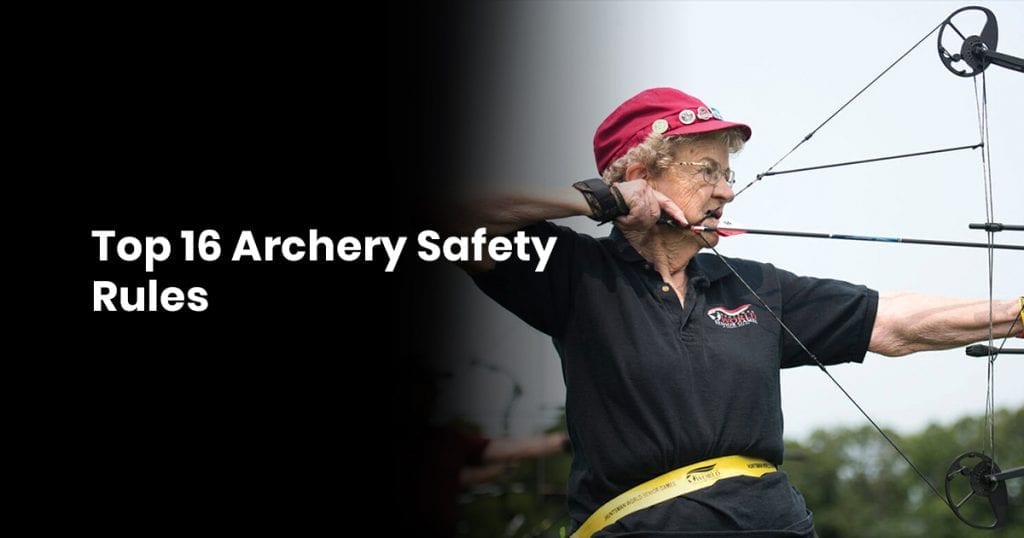Nothing quite beats the tap on a bow release, the sound of fiberglass and steel cutting through the air, and the satisfying thump of your arrow sticking into its target.
There’s nothing better.
However, you still need to have a good idea what the best safety practices are before you can confidently start enjoying archery and avoid any serious injury.
We’ve put together for the first time a list of easier access archery safety rules that are paramount to your success as an archer, and your commitment to keeping yourself and those around you safe from harm.
It only takes one bad release to make a mistake, so a great way to avoid all of the possible problems is by reviewing and memorizing this comprehensive list.
If you’d like to see a graphical breakdown of the archery safety rules, we got you covered:

Share This Image On Your Site
1. Needle on North
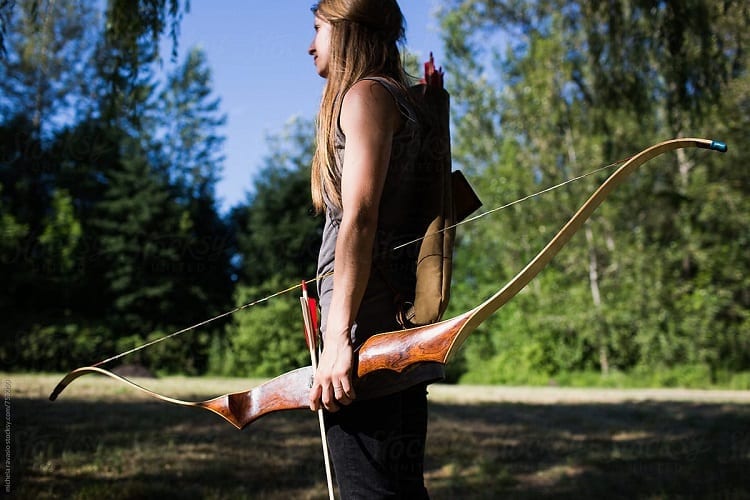
You should never, ever have your bow, whether it’s loaded with an arrow or not, aimed at someone.
Treat it like a firearm.
When you’re already in the habit of making sure it isn’t pointing towards “anyone” or “anything” but the target area, then you’re going to build an automatic sense for how to handle your archery equipment.
Obviously, a bow without an arrow in it or the bow string pulled back isn’t going to hurt anyone within firing line, but it’s about making proper habits and not making anyone feel uneasy or unsafe at the archery range.
Even if you knew a handgun had no magazine in it, you still wouldn’t like the implications of having it pointed at you.
When the arrow is loaded in, only raise it when the vertical axis of your movement will meet the target.
Show good judgment and never sweep a loaded bow from one side to another, always pull up.
To capitalize on this rule, never nock an arrow unless your target is clear taking all safety precautions, conducting maximum safety check and avoiding any bowhunting accidents.
2. Inspect the Target Zone
If you had a standalone target practice on a hay bale in the middle of a field, you still can’t be sure what’s behind it.
Thus ensure there’s a safe backstop. and only shoot in a safe direction.
You need to do a full parameter check before you even have the bow in your hand.
Set it down by a table or a stand at the far end opposite the target, where you would be standing when you decide to shoot, and then do a full security walk.
Can you see what’s behind the target?
Can you see what’s in front of the target (such as structures and items in the way, but not visible in the way of the bullseye)?
Leave no stone unturned, maximise your survival skills, avoiding any possible damage.
If you prepare an area for shooting and have to leave, for any reason, for any period of time where you cannot directly see the target area, then consider it unchecked.
Go around again, check everything over.
3. No Dry Firing
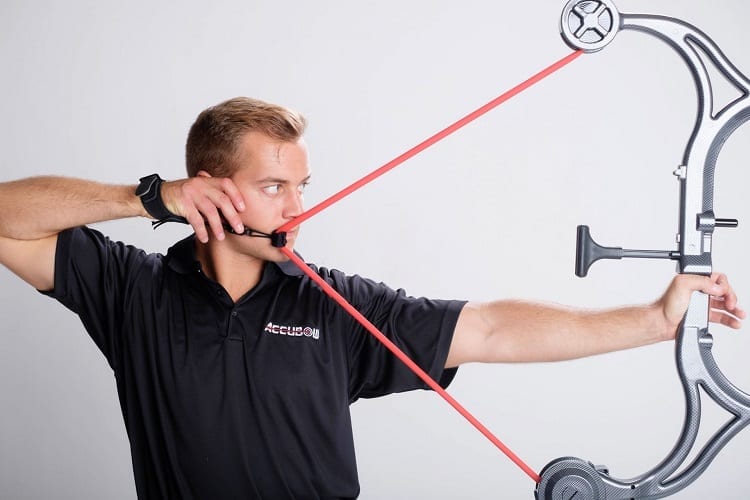
In the sport of archery nocking is when you pull the string back and you prepare to fire an arrow.
Dry firing line is when you pull to nock, but there’s no arrow.
Letting go of the string at that point will simply send it bouncing and vibrating forward, and that momentum or kinetic energy won’t be transferred properly, not a good thing.
When you release an arrow, there’s a physical item in the way of the bowstring moving forward, and the result in the string’s tension is the launching of the bow.
When they’re nothing for that energy to go into, it could result in excessive pressure to the limbs of your bow, as well as injury to your hand. It’s very important to never dry fire.
If you’re going to “mess around” with your bow and toy with it for a bit, never pull more than 5 to 7 pounds of draw weight.
Anything that gives it serious tension.
If you do pull back, do not release: slowly ease off the pressure until the string is in its normal placement.
4. No Straight-Up Shots
This should be common sense, but you’d be surprised how often it, in fact, isn’t.
You can’t perfectly, shoot an arrow straight up in the air, no matter how good your archery skills or shooting skills.
There are a few reasons you can’t, such as the fact that nobody is that pinpoint accurate, but there’s also the rotation of the earth known as the Coriolis effect.
Even if you shot it straight up in the air with perfect angling, the earth is moving and it’s going to come down in a different spot.
There are no trick shots that are worth that.
There’s a huge chance of physical injuries when you do this.
It’s simple; just avoid it, adhere to basic safety. rules.
5. Don’t Disregard Finger Protection
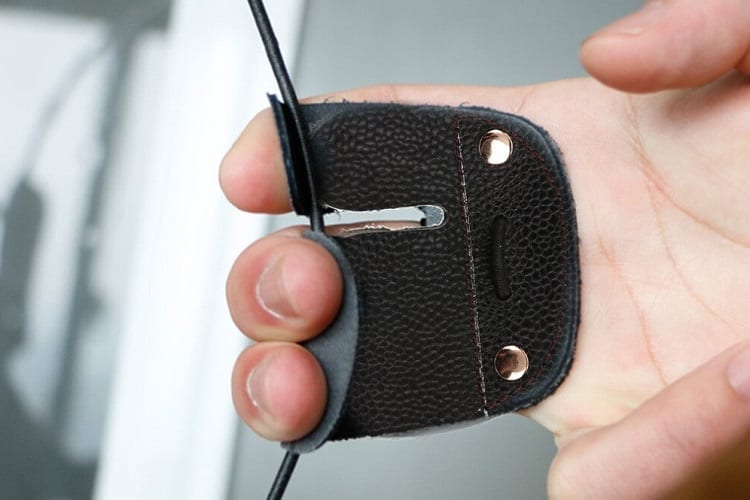
The amount of pressure and sheer speed of a nocked arrow is immense, but that power is coming from the bowstring.
Without the proper protective equipment for your fingers and hands, you’re at the mercy of miscalculations (no matter what skill level), and that backlash is going to sting like nothing you’ve ever felt before, for a long time.
This is where your arm guard is so important.
After a while, it can seem like you’ve stacked up an absolute ton of safety gear for your archery hobby.
Don’t be worried about looking like a newcomer; it’s the experienced archers that know how important safety gear is, wearing the proper clothing, having a first aid kit handy.
You’re bound to make a mistake from time to time or endure equipment malfunctions.
Just be prepared for it, and when that moment finally comes, you’ll be glad you were prepared, ensuring everything is in good working order.
6. Inspect and Repair Any Signs of Damage
Anything can go wrong at any point, so check for signs of wear.
It’s not exactly settling to think about, but it’s the harsh truth.
Best practice you should be prepared for everything, and when you’re vigilant about come-what-may, you’re doing well.
The other thing you need to do on a regular basis is to inspect your equipment.
Inspect the takedown limbs, your bow string, your arrows, and your safety equipment.
In most instances, you can spot a malfunction before it becomes an issue.
To perform a full inspection on your gear, you should have a rhythm to it, and do it every single time before you begin firing.
It can be quick and take as little as 1-2 minutes, but it’s important that it’s thorough.
Make a checklist that you keep with your archery gear, and run through it every time you set up shop.
Eventually, you’ll be faster at your safety checks once you’ve done it a few times (and you might not even need the list anymore).
Repair defects the moment that you see them, and don’t use damaged gear just because “it might be okay”, take the right safety measures to stay safe.
7. Cover Your Quiver
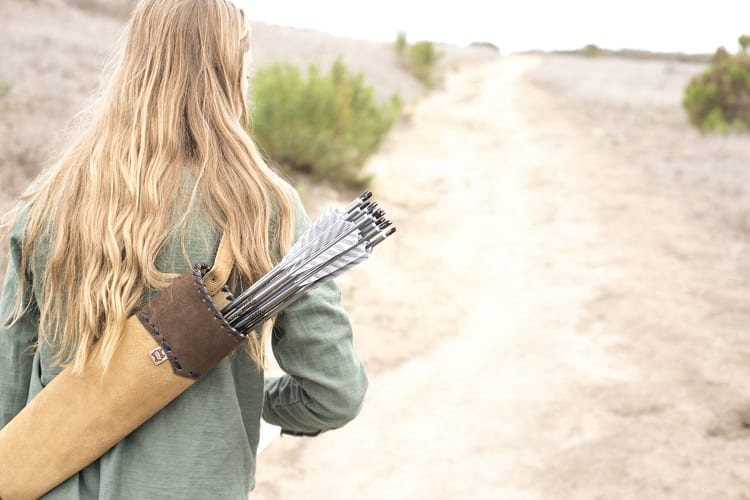
If you’re going full traditional with a quiver on your back, just do yourself a favor and keep it covered.
Whether you’re practicing alone or with other people, a covered arrow net lets you know where your arrows are at all times.
You wouldn’t want to find out that you’d lost one somewhere in the grass, especially good hunting spots that other people use.
8. Store Bows in Hard Cases
Without making too many comparisons to guns and bows, you have to admit that in your trained hands, both could be equally as lethal.
Just as you would keep a firearm in a safe or locked location, you should do the same to your bow.
Purchase a hard case with a simple lock system or added padlock, and keep a spare with somebody that you trust or in a hidden location.
Children can be taught firearm safety and understand just how scary they are—the very design is something they’re repeatedly told about and why it’s bad.
Who’s hosting bow and arrow safety courses for 1st graders?
They might see it as a toy, so treat it like an heirloom and keep it locked uptight.
9. No Drinking or Drug Use – Basic Safety Rules

As with anything, the introduction of alcohol will impair your judgment and capabilities.
It’s not wise to mix drinking with something that could prove potentially fatal when left unchecked.
We have blood alcohol level checks for drivers who get pulled over and are believed to be under the influence.
If they’ve had one drink and their BAC is low, then they are okay.
If you have an archery accident where someone is hurt or killed, any trace amounts of alcohol in your system is going to look bad.
As far as drug use is concerned, this also includes any prescription medication that could have side effects of cognitive impairment (sleeping pills) or promote a hyperactive feeling (uppers).
You have to tread lightly here.
It’s important to discuss your concerns with your prescribing doctor.
Let them know of your coming archery session, and just ask questions to be prepared for the worst-case scenario.
10. Play It Safe With Recurves – Basic Archery Safety Rules
Recurve bows are great for beginners and seasoned professionals alike, but they are a tad bit dangerous.
If you overdraw your recurve bow then you’re running the risk of snapping the string, which is far easier than we make it sound here.
Since the pressure is distributed differently, you could be putting more pressure on your recurve than it truly feels like on your end.
Practice the right pulling methods, and consider using an arrow release in place of your hand.
In the event that a bowstring does snap, that would put you further away from potential harm.
As we mentioned earlier with checking your gear, make sure the strings on your recurve bow are free from splits or signs of extreme distress prior to use.
11. Unstring Before Storage
For recurve bows and longbows alike, you need to unstring at least one end before you put your archery training device away.
This isn’t out of fear of snapping the next time you use it, it’s out of fear that your bow will be permanently bent (more than it is supposed to be) the next time you open that case.
Recurve bows have more pressure being pulled down on them, and longbows share a similar issue as well.
Too much tension over time will either snap the strings, but more likely, it will bend the bow limbs and cause permanent damage.
If it’s five to seven days in between your archery sessions, then it’s not going to take long to see that wear and tear take hold on your bow.
12. No Jewelry Allowed
Bracelets, chains, earrings, and facial piercings—they don’t belong in bowhunting.
If you’re questioning that last one, just think of how close you pull the bowstring towards your face.
There are plenty of examples as to why it’s not good to wear jewelry when doing archery.
If you aren’t in a position to leave them at home, consider purchasing a backpack that includes a hidden valuables pocket, they don’t cost a lot of money.
Bring something along for the ride that can hold onto your jewelry if you have to take the piece(s) off just before picking up the bow.
It’s a minor safety reminder, but one that’s definitely important to remember.
13. Aim for Silence
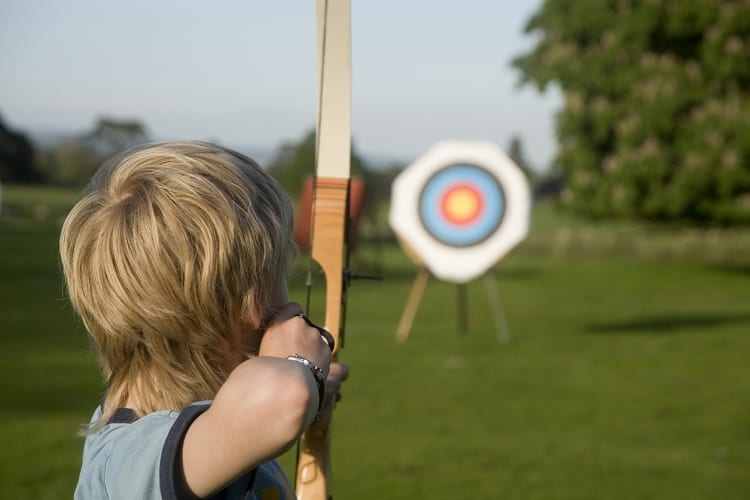
Your surroundings can change in the blink of an eye, especially when you’re focusing on the task right ahead of you, all of a sudden you have a new look around you.
It’s easy to forget that the world is spinning around outside of your current focus bubble, which is all the more reason to take this safety tip into account.
Don’t bring music.
One earbud in your non-dominant ear is not okay; you lose half of your peripheral awareness, and you risk injuring others.
Apart from music, you should aim for total silence.
If you’ve brought a friend along for the ride, don’t strike up a conversation with them while you’re nocking the arrow.
Let them know that when it comes time to draw and fire, you need silence for concentration.
No distractions, no problems; you’re minimizing a lot of risks by doing this.
14. Hundred Shot Wax
Did you know that you’re supposed to wax your bowstrings?
Each manufacturer will have their own specifications, but in the event that they don’t or you received a bow as a gift, you should aim for every one-hundred shots.
Failing to wax your bowstring could mean that your shots won’t release accurately.
The wax wears down unevenly, and that could affect your arrow flight path.
If you suspect that your bowstring wax isn’t up to snuff, then it’s important to stop what you’re doing and wax it before you continue.
If you bring along a bit of string wax, you can usually do this on the scene of wherever you’re practicing or competing.
If you’re hunting with your bow, your tree stand hours would be a great opportunity to carefully and methodically wax your bowstring.
15. Practice Clear and Concise Replies
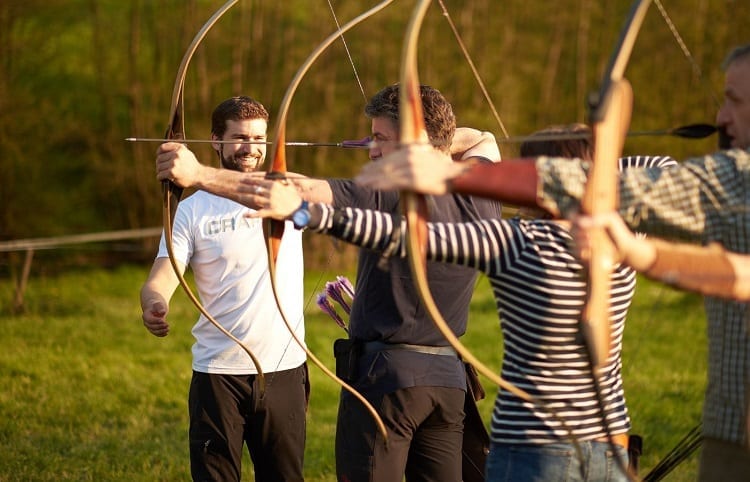
This applies to competitors and firing range regulars, but it’s an excellent tip.
It can also work well if you’re bow hunting with a friend.
Learn how to properly communicate with your team/instructors/fellow competitors.
When you hear hold, you hold.
You keep that arrow drawn and pointed towards the ground temporarily.
Simple one-word commands, such as “South” to instruct others to aim their bows down, or “Clear” to indicate that the playing field is wide open and safe.
16. Know Where the First Aid Kit Is Located
When all is said and done, you need to know where the first aid kit is.
Even when you follow a list of safety rules and tips like this one, you’re still at risk for making a mistake.
You’re just at a much, much lower chance of those mistakes.
Accidents happen, and when you’re being as careful as possible, those accidents don’t tend to be too bad.
Have access to a first-aid kit.
It should be reachable within 15 seconds of a possible accident.
Whether you keep this under the passenger seat of your car, or you keep a small one in your archery backpack, just have something on-hand.
Since one of the most likely injuries is a cut or laceration from an arrow tip, be sure to have plenty of antiseptic spray/hydrogen peroxide available, just to be safe.
Quick-acting ice packs are also good if the injury is a sprained knuckle or injured arm.
Enjoy Hitting Your Mark Safely
You’ve been thinking about firing at a target while reading this whole post—get out there, be safe, and enjoy every second that you have.
There’s a lot of patience and rigorous training that goes into being a safe, confident archer who plays by the book, but there’s also a huge reward in it.
Get back to what you love, and be sure to check out other great lists and helpful information on our site to keen your archer know-how as sharp as your arrows.

